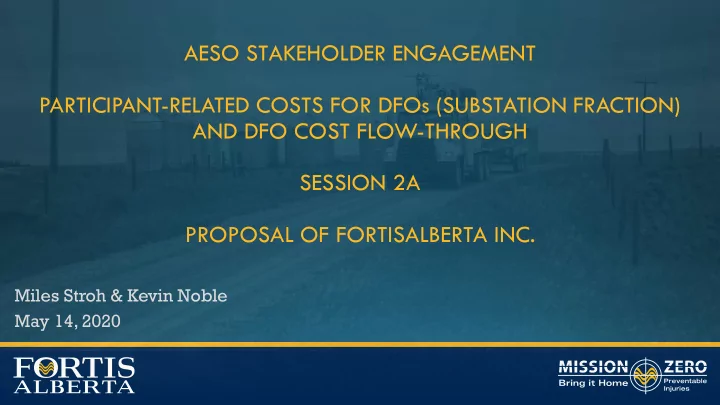

AESO STAKEHOLDER ENGAGEMENT PARTICIPANT-RELATED COSTS FOR DFOs (SUBSTATION FRACTION) AND DFO COST FLOW-THROUGH SESSION 2A PROPOSAL OF FORTISALBERTA INC. Miles Stroh & Kevin Noble May 14, 2020
Outline of Presentation 1.0 Overview of Proposal 2.0 Principles 3.0 Proposal Details 3.1 Timing 3.2 Process Flow 3.3 Examples 4.0 Implications of Proposal 4.1 Benefits 4.2 Risks 4.3 Impacts by Stakeholder
1.0 Overview: Contribution Allocation Method for DFO-contracted PODs Replace it with a more direct allocation method: Average Supply-related Interconnection Contribution (“ASIC”) Requires decoupling of the load (DTS) and supply (STS) side of the ISO tariff’s customer contribution policy DFO’s load side carries on as is but with a DTS fraction = 1.0
Contribution Timing, Process and Flow-through to DCG ASIC: Full flow-through the DFO’s distribution tariff & charged to DCG: Retains the integrity of the transmission contribution price signal that the AESO wishes to send to supply Supports cost causation, parity with treatment of transmission-connected generation (TCG) ASIC amounts paid by DCG would be returned to the TFO via the ISO and distribution tariffs, resulting in an offset to TFO rate base AESO/TFO to design a DTS POD-specific credit rider to be returned to load
Determination of Magnitude/Level of ASIC Contribution to DCG Based on a case-by-case technical cost analysis and allocation (direct assignment) at the time of DCG grid entry (STS contracting) AESO should work with the TFOs and DFOs to develop an average province-wide supply-related contribution schedule per unit ASIC $ /supply-related capacity (MW) Forms part of the ISO tariff and could be reviewed/adjusted annually in the AESO’s annual tariff update applications
Determination of Magnitude/Level of ASIC Contribution to DCG local transmission cost components based on supply’s (DCG’s) use distribution voltage feeder 3) breaker and bus POD substation transformer 2) local transmission line 1)
Determination of Magnitude/Level of ASIC Contribution to DCG
2.0 Principles fair, efficient and openly competitive market (FEOC). cost causation parity between the transmission interconnection costs providing effective price signals
3.1 Timing Costs should not be, subsequently, added to the upfront supply-related price signals provided at the time of DCG connection. Similarly, additional costs should not be allocated to DCG customers as a result of local transmission system upgrades, driven by load, after the interconnection of the DCG. An exception to this would be when a DCG proponent implements an increase in exported power onto the grid.
3.2 Process Flow
3.2 Process Flow ASIC Calculation ASIC= ASIC breaker + ASIC trans ASIC = [(RP breaker x $/MW breaker ) x UF breaker ]+[(RP trans x $/MW trans ) x UF trans ] Where: RP = Reverse power flow on transmission component $/MW = Average cost per MW of reverse power flow on transmission component UF = Utilization factor on transmission component
3.2 Process Flow Utilization Factor Calculation UF =(CF DCG x MRP)/[( CF DCG x MRP)+(LF x PL)] Where: UF = Utilization factor of the transmission component CF DCG = Capacity Factor of the DCG MRP = Maximum reverse power on transmission component LF = Load factor on transmission component PL = Peak load on transmission component
3.2 Process Flow
3.3 Example Average maximum Transmission Component Average cost reverse power flow capacity Distribution voltage feeder $1.0M 25 MW breaker and bus Substation stepdown transformer, $3.6M 40 MW breakers and bus
3.3 Example #1 – Breaker Level Reverse Power Component (w) (x) (y) (z) (w*x)/[(w*x)+(y*z)] Maximum Component Peak Reverse DCG Capacity Component Power (MW) Factor Load Load Factor Utilization Factor (1) Distribution voltage 4.0 0.33 12.0 0.64 0.15 feeder breaker (2) POD Substation 0.0 0.33 27.0 0.77 0.00 Transformer (e) Step 8 Component (a) Step 1 (b) step 4 (c) Step 5** (d) Step 6 (e) Step 7 (c/d) (a x b x e) Magnitude of Required DCG Reverse Power flow Ave installed cost Installed cost per Usage Contribution (MW) Utilization Factor ($k) Capacity (MW) MW ($k) ($k) (1) Distribution voltage feeder 4.0 0.15 $1,000 25 $40 $24 breaker (2) POD Substation 0.0 0.14 $3,600 40 $90 $0 Transformer Total required DCG usage contribution of all components ($k) $24
3.3 Example #2 – POD Level Reverse Power Component (w) (x) (y) (z) (w*x)/[(w*x)+(y*z)] Maximum Component DCG Peak Reverse Power Capacity Component (MW) Factor Load Load Factor Utilization Factor (1) Distribution voltage 22.7 0.33 5.0 0.71 0.68 feeder breaker (2) POD Substation 20.5 0.33 12.0 0.87 0.39 Transformer (e) Step 8 Component (a) Step 1 (b) step 4 (c) Step 5 (d) Step 6 (e) Step 7 (c/d) (a x b x e) Magnitude of Required DCG Reverse Power flow Ave installed cost Installed cost per Usage Contribution (MW) Utilization Factor ($k) Capacity (MW) MW ($k) ($k) (1) Distribution voltage feeder 22.7 0.68 $1,000 25 $40 $616 breaker (2) POD Substation 20.5 0.39 $3,600 40 $90 $725 Transformer Total required DCG usage contribution of all components ($k) $1,342
4.0 Implementation of Proposal 4.1 Benefits
4.2 Risks . AESO would also have to design POD specific riders in its ISO tariff as a means to compensate the DFO’s load customers in the form of lower DTS POD charges for the DCGs’ payment of ASIC (offsetting TFO rate base at these DFO-contracted PODs). Transition plan required for application to DCGs in queue / connected. Helpful for the AESO to develop an Information Document (ID) to make its CCD timing and contracting practices and policies more clear, consistent and transparent for its DFO and DCG customers.
4.3 Impacts on Stakeholders DCG: DFOs:
4.3 Impacts on Stakeholders AESO: Requires amendments and approvals to ISO tariff to Differentiate between the application of its customer contribution policy to DFO- contracted PODs versus non-DFO-contracted PODs Codify the ASIC levels and mechanism, and POD-specific credit riders, in its tariff Transition / Grandfathering Plan to ASIC mechanism Develop an Information Document (ID) re: same. TFOs: Requires TFOs to assist the AESO to determine the average transmission costs by component and POD-specific credit riders for DCG payment of ASIC contributions.
End
Recommend
More recommend